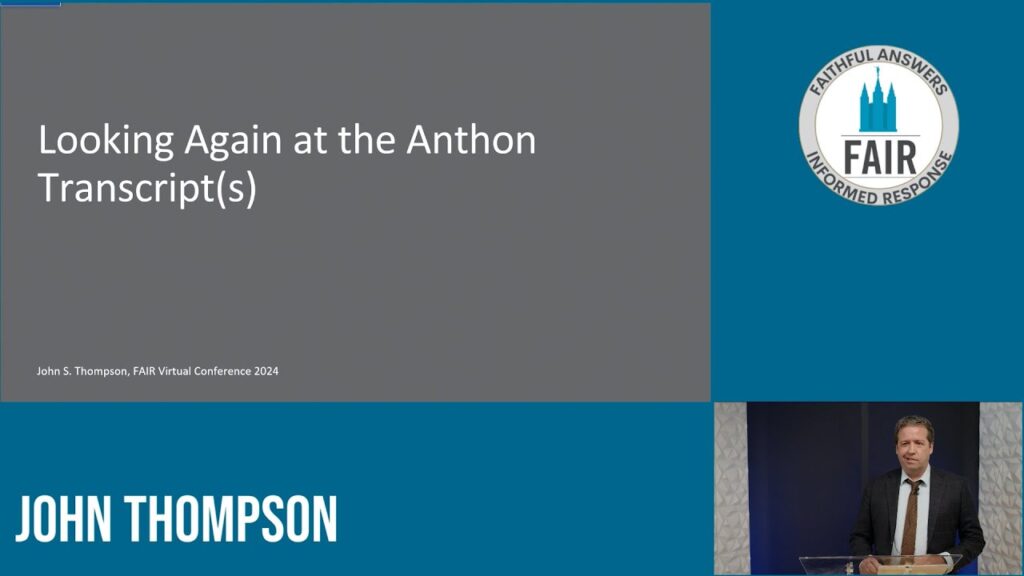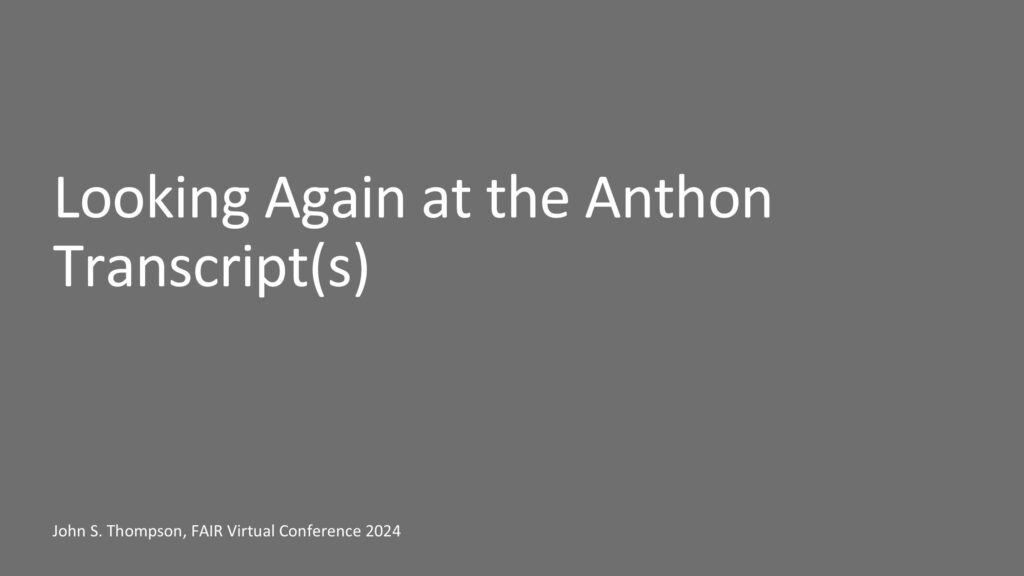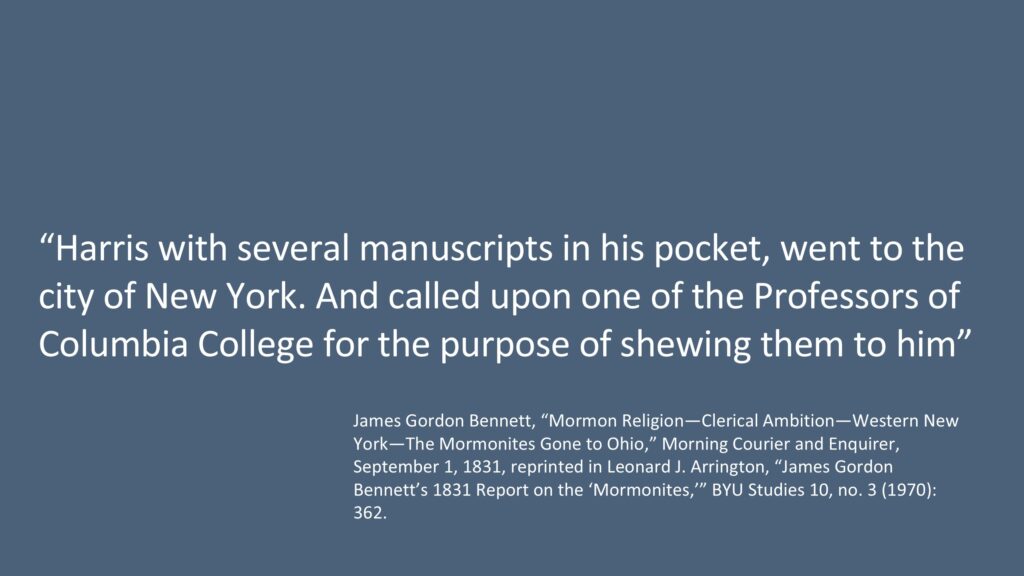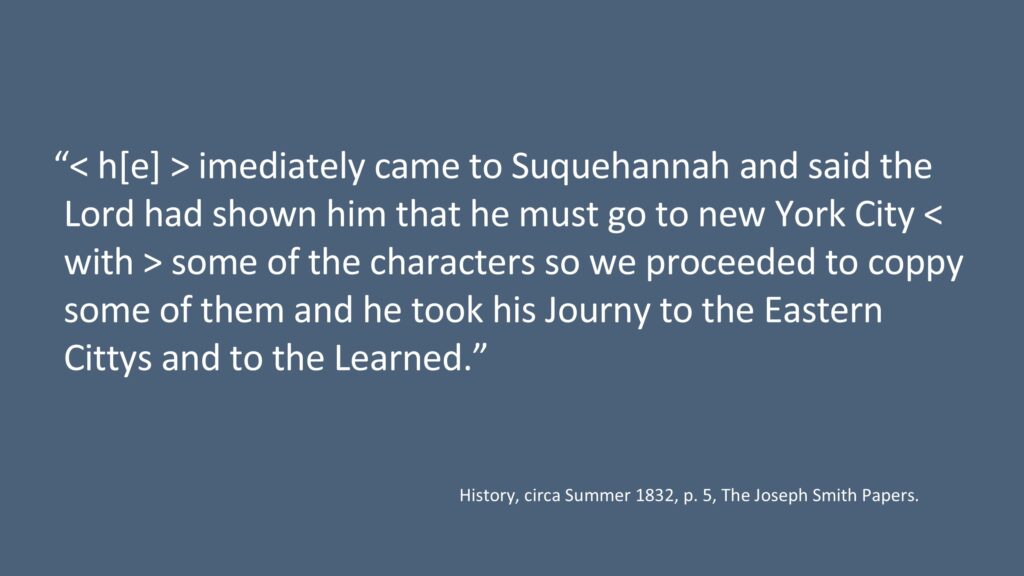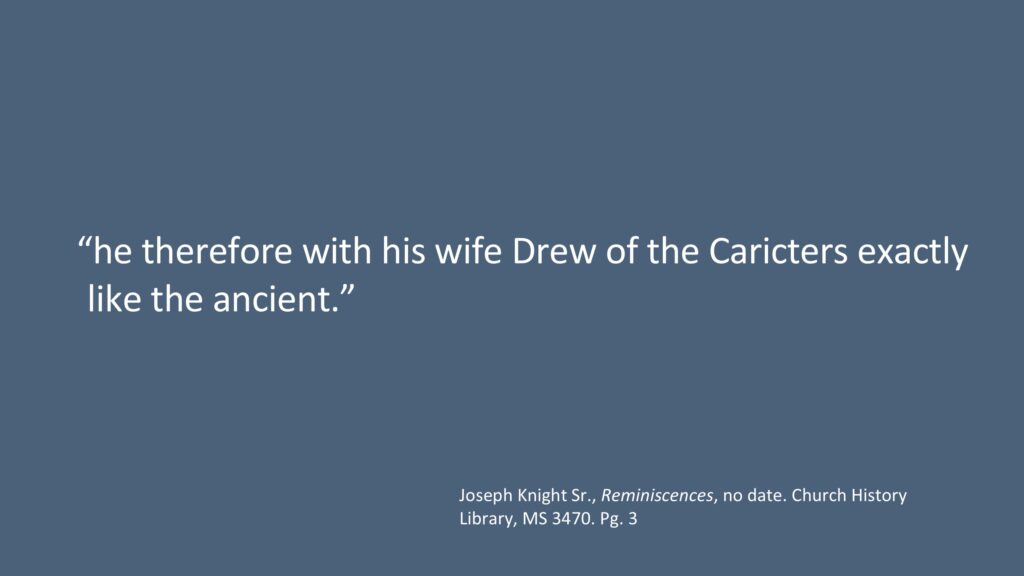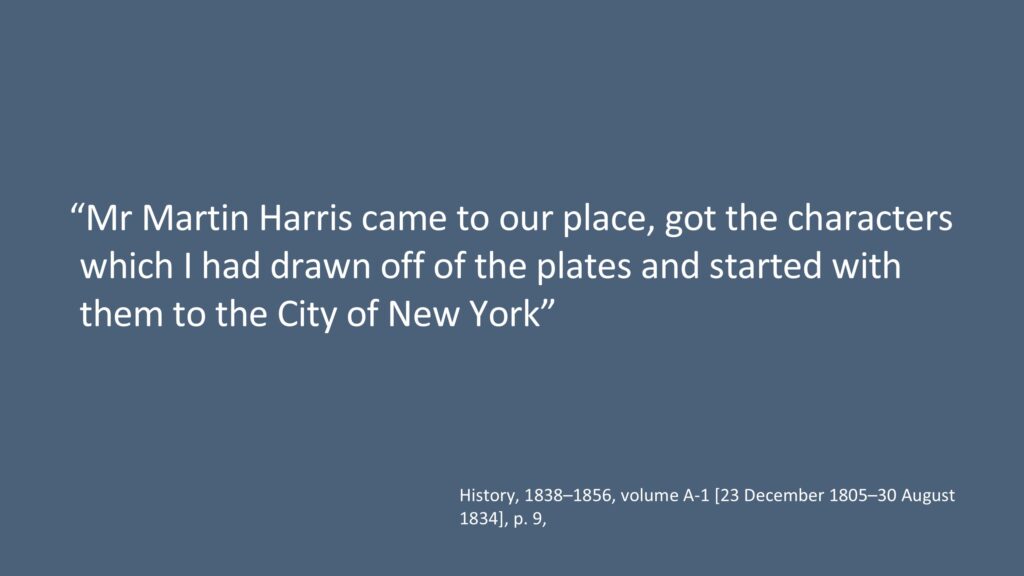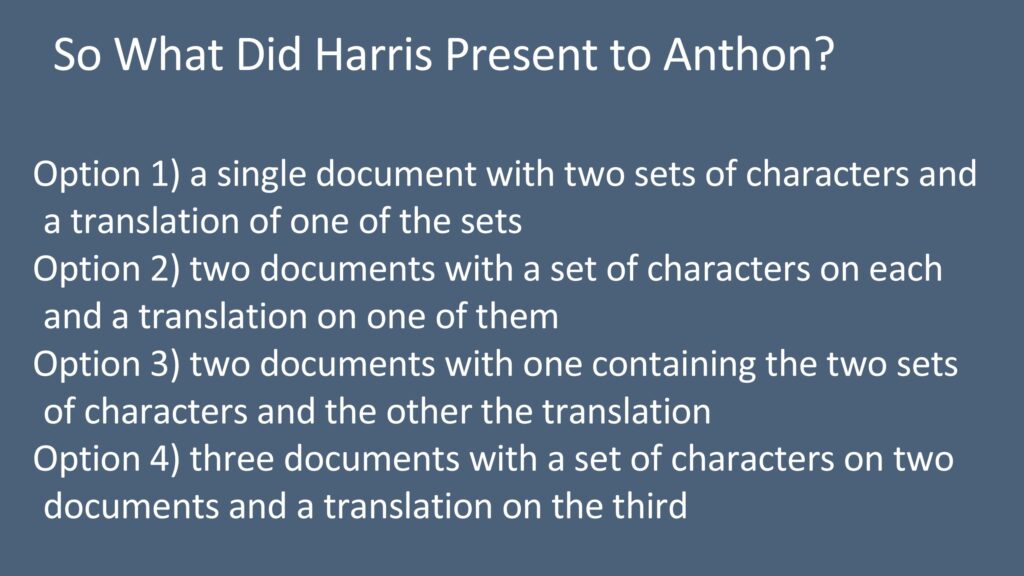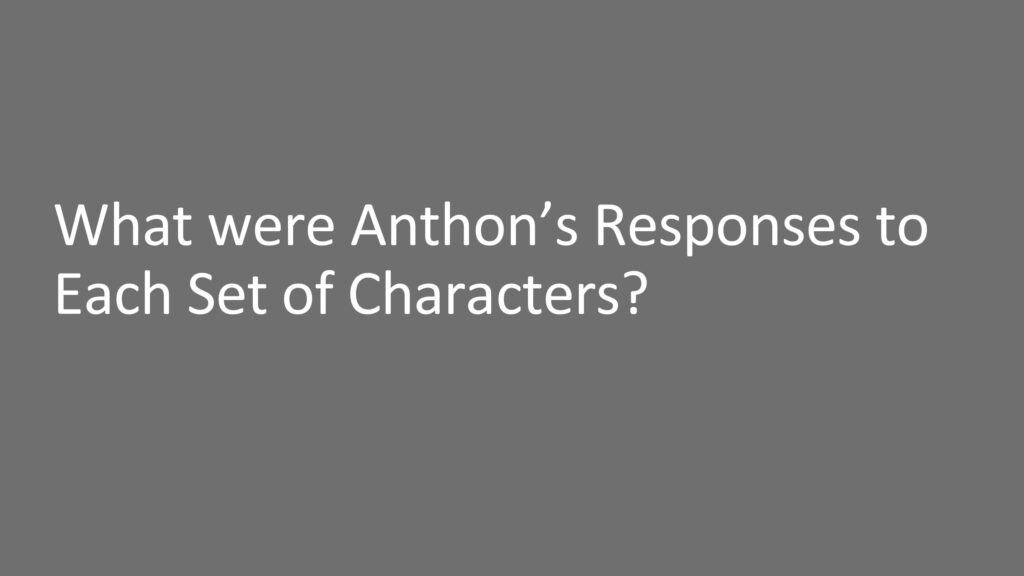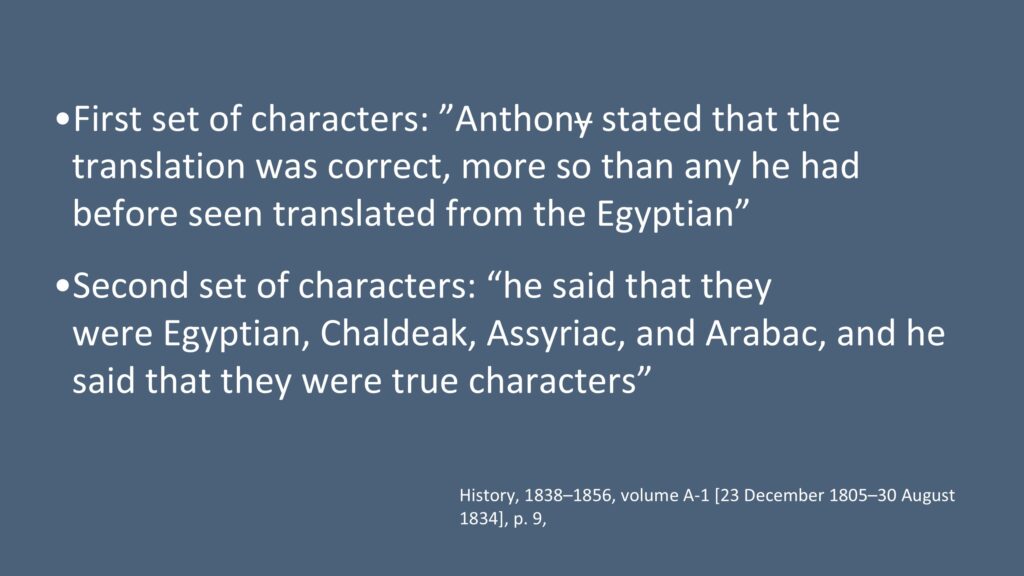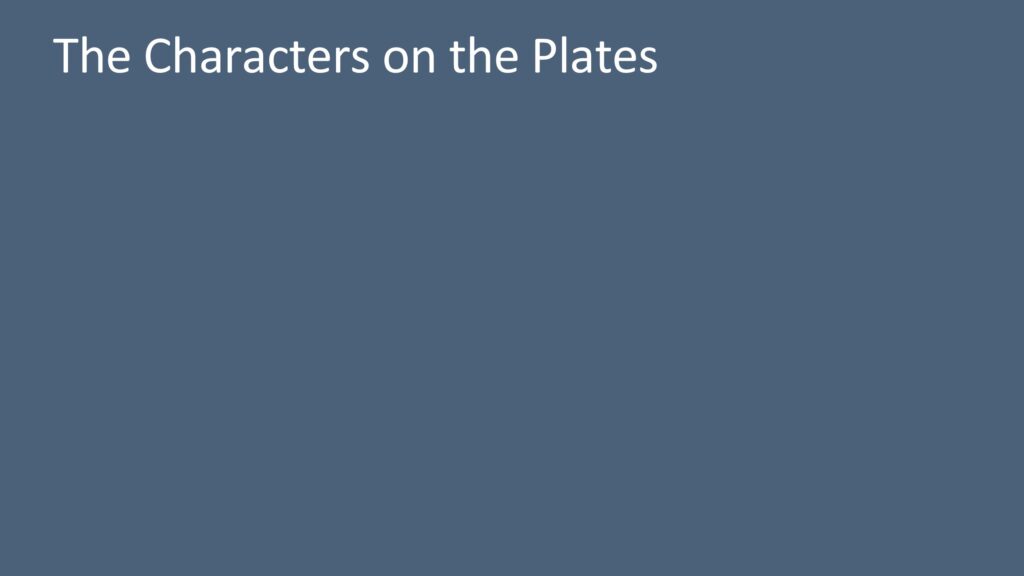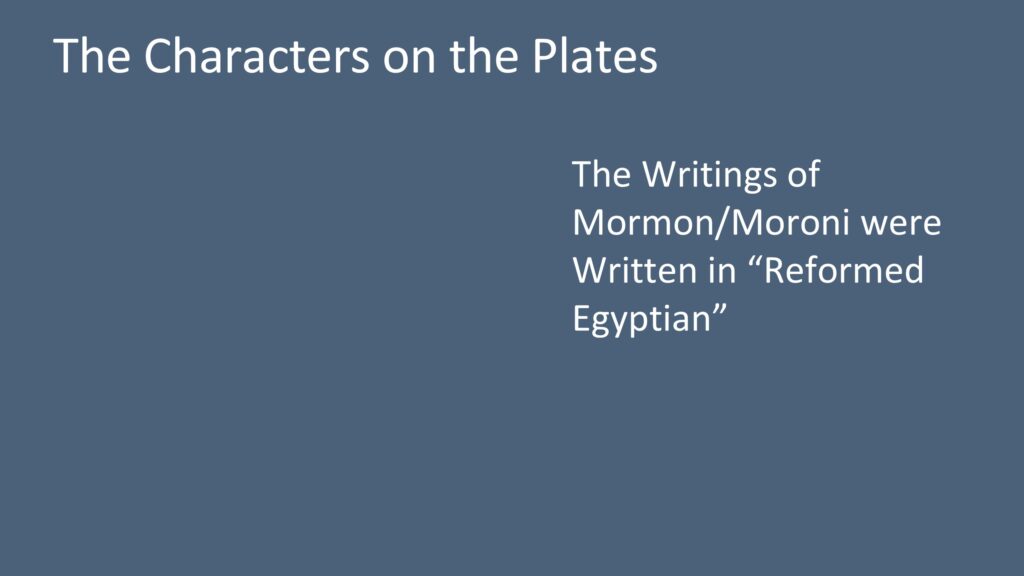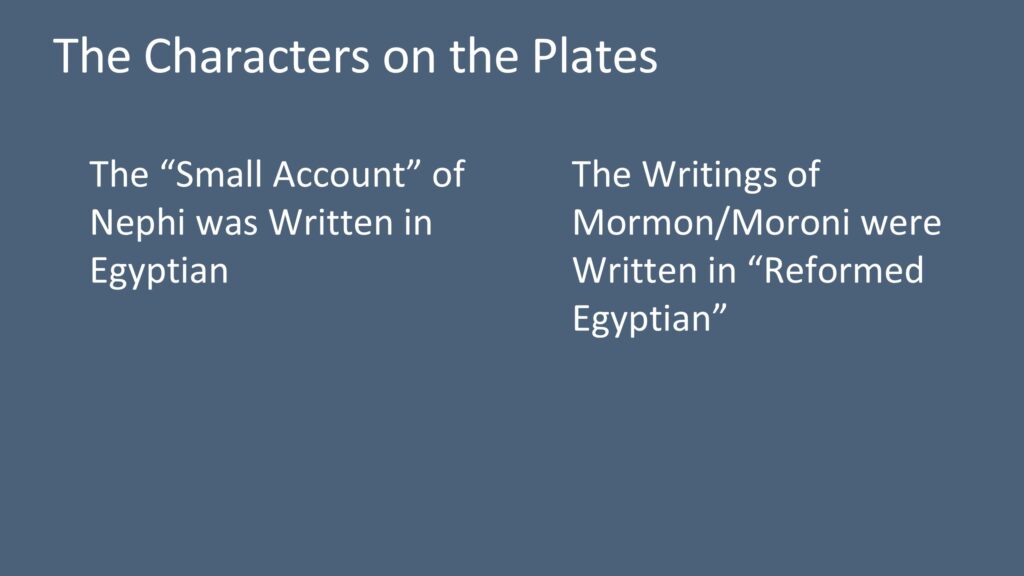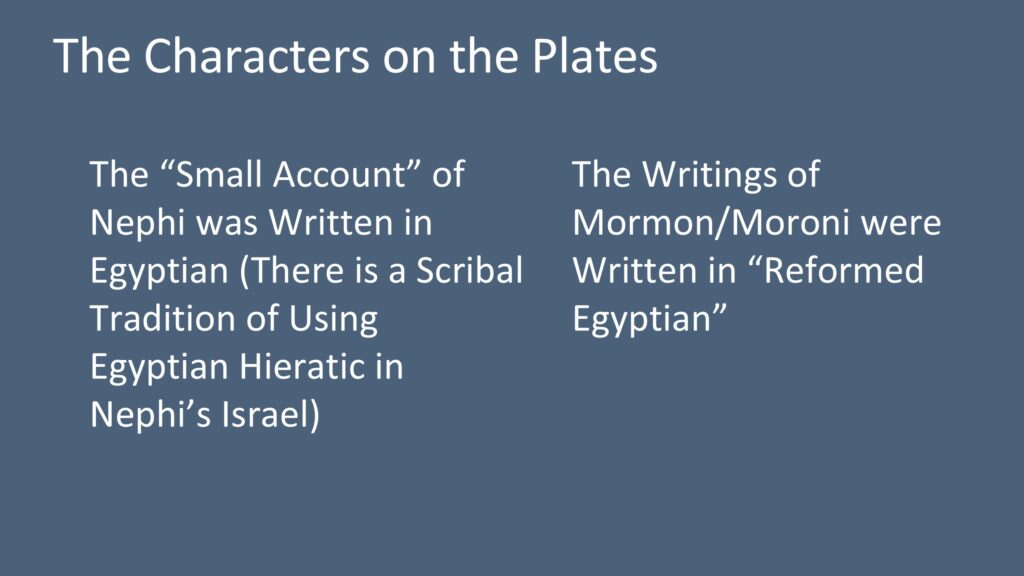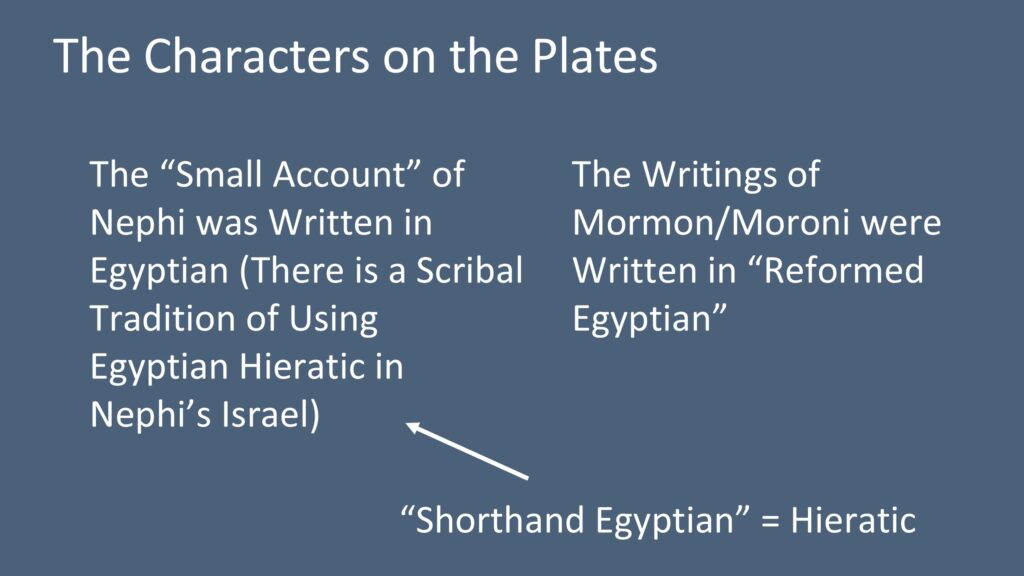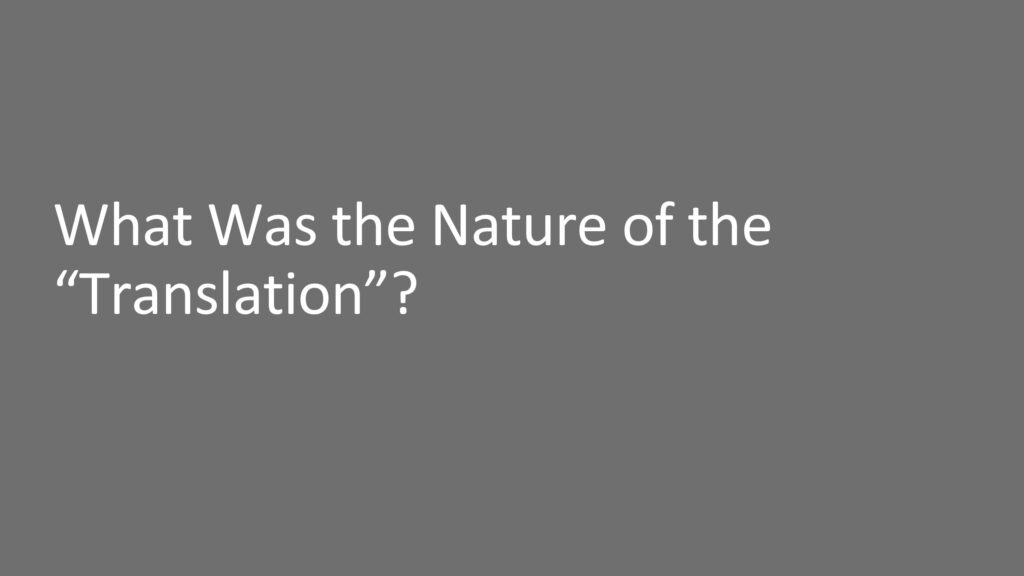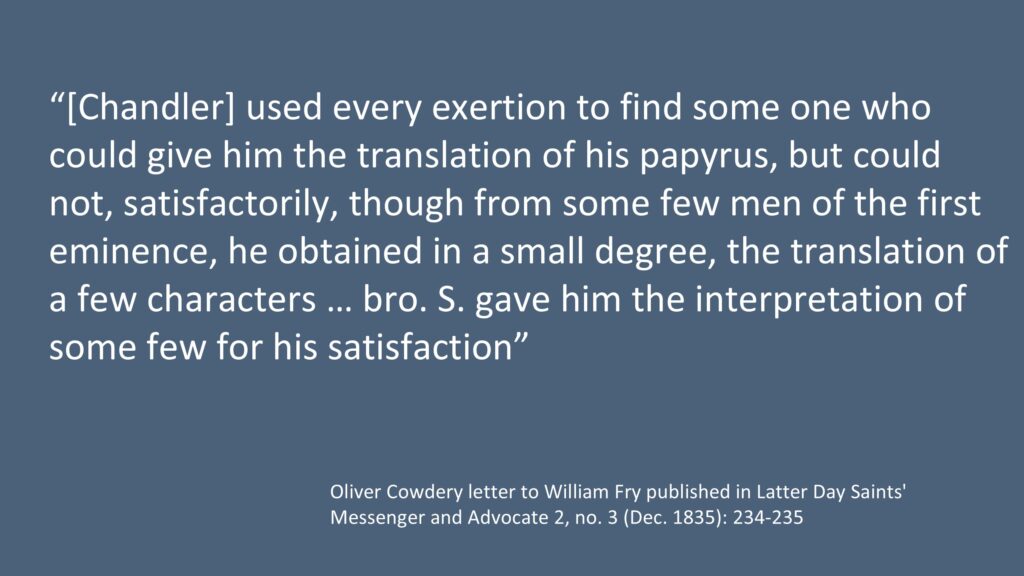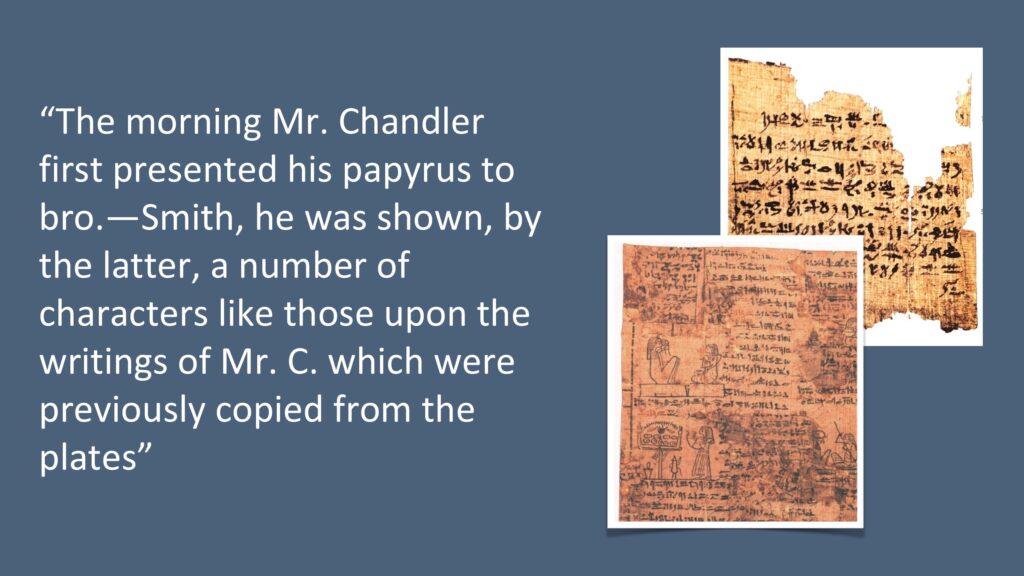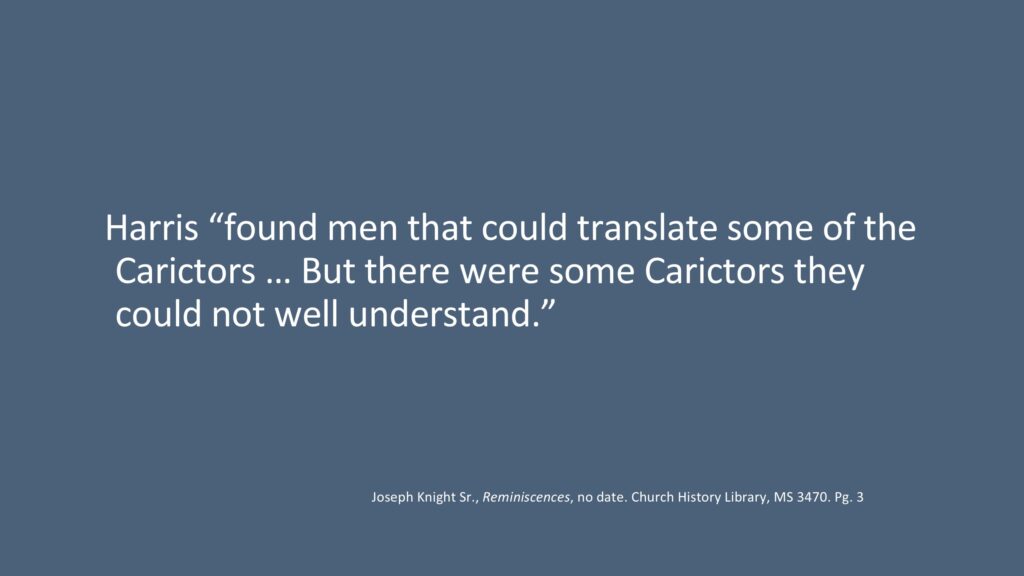This talk by John S. Thompson delves into the historical details surrounding the Anthon Transcripts, analyzing Martin Harris’s 1828 meeting with Professor Charles Anthon. The presentation examines differing historical accounts, the scripts shown to Anthon, and the implications of his responses. It explores the possibility of two distinct sets of characters—hieratic Egyptian from Nephi’s time and reformed Egyptian used by Mormon and Moroni. The discussion highlights how these findings align with the Book of Mormon’s narrative and addresses common criticisms of the historicity of reformed Egyptian. Thompson also contrasts Anthon’s remarks with historical and archaeological evidence to build a nuanced understanding of this significant event.
This talk was given at the 2024 FAIR Virtual Conference, “Understanding and Defending the History of the Church“, in American Fork, Utah on October 12, 2024.

John S. Thompson, PhD in Egyptology from the University of Pennsylvania, is a researcher and writer for Scripture Central specializing in early Egyptian religion, the Book of Abraham, and covenant theology.
Transcript
Introducing John S. Thompson
Scott Gordon: Our next speaker is John S. Thompson. He obtained his BA and MA in Ancient Near Eastern Studies and Hebrew Bible from BYU and UC Berkeley, respectively, and completed a PhD in Egyptology at the University of Pennsylvania. He was an employee of the Seminaries and Institutes of Religion for 28 years, most recently serving as coordinator and institute director in the Cambridge, Massachusetts area.
Now a full-time researcher and writer for Scripture Central, John’s research and publications focus primarily on early Egyptian religion, the Book of Abraham, and ancient and modern priesthood, temple ritual, and covenant theology. He and his wife, Stacy, make their home in Utah, where they welcome their nine children and four grandchildren.
With that, we’ll turn the time over to John.
John S. Thompson
Looking Again at the Anthon Transcript(s)
A Personal Note from John
Thank you, Scott. Just a personal note before we get started: I feel a little self-conscious today. I recently suffered a paralysis of my face just a few days ago. So, if it looks like I’m trying to mimic Popeye the Sailor as I speak, that may explain why. It also becomes more apparent when I smile, so I’ll try to maintain a nice scholarly stoicism throughout this presentation to avoid alarming anyone. With that, let’s get started.
Exploring the Historical Sources
Some confusion exists in the written historical sources concerning the number and nature of the transcripts that Martin Harris presented to Professor Charles Anthon at Columbia College in 1828. Some sources seem to indicate—and standard thinking has asserted—that Harris showed Anthon one document containing a collection of characters copied from the golden plates.
However, other sources, including the canonized account of Harris’s visit with Anthon, recorded in Joseph Smith–History 1:63-65, suggest that Harris may have shown Anthon at least two pieces of paper, as B.H. Roberts already noted long ago.
Martin Harris’s Report on the Anthon Transcripts
Harris’s canonized report, as it appears in the manuscript of the History of the Church begun in 1838, states:
“I went to the City of New York and presented the Characters which had been translated [C1], with the translation thereof [T], to Professor <Charles> Anthony a gentleman celebrated for his literary attainments. Professor Anthony stated that the translation was correct, more so than any he had before seen translated from the Egyptian [R1]. I then shewed him those which were not yet translated [C2], and he said that they were Egyptian, Chaldeak, Assyriac, and Arabac, and he said that they were true characters [R2].”
While the number of documents is not addressed in this report and therefore remains uncertain, Martin Harris explicitly states that he presented Anthon two different sets of characters. One set was translated, and the other was not yet translated. These are labeled C1 and C2 in the accompanying slide.
Harris also reports Anthon’s differing responses to these two sets of characters, which are labeled R1 and R2 in the slide.
Analyzing the Evidence of Characters Presented to Anthon
These details provide some additional possibilities to consider with respect to the kinds of characters Anthon was shown, as well as his ability to identify or translate them. A third-hand source from 1831 also suggested that Harris, with several manuscripts in his pocket, went to the city of New York and called upon one of the professors at Columbia College for the purpose of showing them to him.
Background on Historical Accounts
A little background will be helpful here. Apart from the multiple documents mentioned in the 1831 source and Charles Anthon’s personal letters—wherein he only mentions being shown a singular document—most of the sources actually say little or nothing about the number of documents that may have been carried by Harris and presented to Anthon.
Insights from Joseph Smith’s 1838 History
Joseph Smith’s 1838 History states:
“Immediately after my [Joseph Smith’s] arrival there [in Pennsylvania] I commenced copying the characters of all the plates. I copyed [sic] a considerable number of them and by means of the Urim and Thummin I translated some of them.”
As in the 1832 account, nothing in this version indicates the number of documents made, only that a “considerable number” of characters were copied and that “some” of these characters were translated.
Uncertainty in the Details
That is as far as these sentences allow one to go when creating history. It cannot even be determined where the translation was written—was it right next to the characters on the same document, or was it on a separate document? It’s not clear.
Note that this text originally stated Joseph Smith copied characters of “all the plates,” but then “all” is crossed out, presumably because it goes too far. The initial reading and correction certainly give the impression that characters were copied from more than one plate, just not all of them.
Joseph Knight Sr’s Rememberance
Indeed, more recent scholarship has demonstrated that Joseph Smith may have created many copies of characters from the golden plates while he possessed them, some having different formats or appearances than others. Joseph Knight Sr. states that Joseph and Emma Smith drew off the characters “exactly like the ancient,” suggesting they took care in rendering facsimile copies of the characters on paper as they appeared on the plates. He also makes no remark as to the number of documents made.
What Did Martin Harris Present to Anthon?
The 1838 history goes on to say that Mr. Martin Harris “came to our place, got the characters which I had drawn off of the plates, and started with them to the city of New York.” Again, the text does not actually specify a number of documents. It only says he “got the characters,” without any reference to their physical context.
Possible Scenarios for the Presentation
So, what did Harris present to Anthon? Based on these sources and others, particularly Harris’s account in the history of the Church, the following options are possible:
- Option 1) Harris presented a single document (D) with two sets of characters and a translation of one of the sets (D=C1+T+C2)
- Option 2) Harris presented two documents with a set of characters on each and a translation on one of them (D1=C1+T; D2=C2)
- Option 3) Harris presented two documents with one containing the two sets of characters and the other the translation (D1=C1+C2; D2=T)
- Option 4) Harris presented three documents with a set of characters on each of two documents and a translation on the third (D1=C1; D2=T of C1; D3=C2)
Any of the documents could have writing on the front or back, or both.
Determining the Most Likely Option
Harris’s report that he presented the first set of characters with the translation thereof and then received Anthon’s reaction to them—before later showing him a second set of characters and receiving a second reaction—is more consistent with options two or four. However, option two is more likely since the first character set was presented with the translation.
Examining Anthon’s Reactions
Let’s inspect a little more closely the two responses Anthon gave in Harris’s report. When Anthon was presented with the first set of characters and their translation, he, according to Harris, simply identified the characters as being from the Egyptian and noted that the translation appeared to be correct.
Although Martin Harris or Anthon could be using the term “Egyptian” generically for an ancient script (similar to the phrase, “It’s all Greek to me”), the possibility that Anthon actually identified this set of characters as recognizably Egyptian should not be ruled out. One of his main purposes for inspecting the characters was to identify their origin.
Identifying vs Ability to Translate
In his academic position, Anthon would have been exposed to various forms of Egyptian writing and could likely identify them, regardless of his level of ability to translate such scripts. However, when Anthon was presented with the second set of characters—those that were not yet translated—he seemed less certain of any singular language origin. He stated that some characters looked Egyptian, while others looked Chaldaic, Assyriac, or Arabic.
Verifying the Antiquity of the Characters
As an aside, it should be noted that Anthon’s own letters recounting Harris’s visit unwittingly verified the antiquity of many of the characters. He speculated that they must have been copied from a book of various alphabets, albeit in a nonsensical manner.
Two Different Scripts Shown to Anthon
At face value, the difference between these two responses can be viewed as evidence that two different scripts were shown to Anthon. A script Anthon simply identified as “Egyptian”, and another script containing characters of a less certain origin. The possibility that two different scripts were shown to Anthon—one that he called Egyptian and one that he was not sure about—would actually be in harmony with claims within the Book of Mormon itself.
The Abridgement of the Large Plates was in Reformed Egyptian
Mormon and Moroni, who lived around 400 AD, created an abridgment of the main Nephite records using a language that had been altered over their thousand-year history, a language which they called reformed Egyptian. It was reformed so much that Mormon said, “none other people knoweth our language,” suggesting that even an ancient Egyptian would not have understood their language, in spite of the name given.
Mormon’s Inclusion of Nephi’s Small Plates
Mormon, however, noted that as he was creating his abridgment of the main Nephite history, he searched among the records and found the set of plates that contained the small account written by Nephi, Jacob, and others down to King Benjamin. He felt they were important to include and indicated that he would simply place them with the remainder of his abridgment.
Nephi Wrote “Using the Language of the Egyptians”
Since Nephi and Jacob lived around a thousand years before Mormon and Moroni, the language and characters on this small record would not have been the altered reformed Egyptian that Mormon and Moroni used.
Rather, Nephi tells his readers plainly that he wrote using the language of the Egyptians, a language that his father, Lehi, knew how to read and had taught to his children.
Hieratic Egyptian in Nephi’s Time
It is known from archaeology that there was a scribal tradition using Egyptian hieratic in Israel during Nephi’s day. This script is the leading candidate for the script Nephi used when making his record. If this additional small account of Nephi, which Mormon placed with the remainder of his abridgment, had been written in the Egyptian language—like hieratic—that was used in Lehi and Nephi’s day, while Mormon and Moroni’s writings, including the title page, were written in reformed Egyptian, then it is reasonable to postulate that two different scripts would have been found on the bundle of plates that Joseph Smith received.
This may explain the different reactions of Charles Anthon to the two character sets presented to him by Martin Harris: one set, which he declared to be Egyptian, and the other, which he could not definitively identify but said had features of multiple ancient languages.
Anthon’s Description of the Characters
Anthon himself would later claim that the characters he saw were anything but Egyptian hieroglyphics. However, it has already been noted that Anthon probably did tell Harris that some of the characters looked Egyptian. After their meeting, it began to circulate among the Latter-day Saints that Anthon had told Harris some of the characters appeared to be shorthand Egyptian.
Shorthand Egyptian
This distinctive term was something that scholars, including Champollion himself, were using in their publications to specifically describe hieratic Egyptian script. It was unlikely a term that Harris would have known unless Anthon actually said it to him. Egyptian hieratic is an attested scribal script in Nephi’s Israel, and Anthon supposedly saying the characters looked like shorthand Egyptian could be significant.
Anthon’s Familiarity with Egyptian Writing
Let’s pivot for a moment and discuss Harris’s report that Anthon indicated the translation from the Egyptian characters in the first transcript was correct. Although translating Egyptian characters was still in its infancy, Anthon was familiar with Champollion’s earliest work and mentioned it in his 1825 reworking of a classical dictionary. He also owned a personal copy of Champollion’s 1824 summary of the hieroglyphic system of the ancient Egyptians.
At the least, Anthon understood from Champollion’s work that Egyptian was a phonetic language, having characters that represented sounds, not just logograms or symbolic writing. Consequently, for Anthon to have made any substantive and affirming remark concerning a translation, the translation that Harris presented would need to have been something simple, like alphabetic equivalences, and related to the characters that Anthon recognized—not the reformed Egyptian characters.
Joseph Smith’s Efforts and Anthon’s Comments
While the depth of Anthon’s understanding of various Egyptian scripts and their values is uncertain, there is evidence in the sources—including some attributed to Joseph Smith’s own parents—that suggests Joseph Smith may have attempted to create and send something like an alphabet with Harris. Consequently, Anthon’s comment to Harris that the translation from the Egyptian was correct may have been a simple acknowledgment of rudimentary ideas, such as characters having alphabetic features.
Joseph Smith’s initial interaction with the characters on the Egyptian papyri brought to him by Michael Chandler—from which the Book of Abraham originates—may have some bearing on this moment. Oliver Cowdery published a letter that he had written concerning this initial meeting, in which he says:
Michael Chandler’s Efforts to Translate the Papyri
While Michael Chandler was in Philadelphia, he used every exertion to find someone who could give him the translation of his papyrus, but he could not do so satisfactorily. Though from some few men of the first eminence, he obtained a small degree of the translation of a few characters. Mr. Chandler was told that his writings could be deciphered and very politely gave Cowdery the privilege of copying some four or five different sentences on separate pieces. At the same time, he stated that unless he found someone who could give him a translation soon, he would carry them to London.
Cowdery goes on: “I’m a little in advance of my narration. The morning Mr. Chandler first presented his papyrus to Brother Smith, he was shown by the latter a number of characters like those written upon… sorry, those upon the writings of Mr. Chandler, which were previously copied from the plates containing the history of the Nephites or Book of Mormon.”
Joseph Smith’s Comparison of Characters
Joseph Smith pulls out some characters from the plates and shows them to Chandler. They compare them to the documents that Chandler had. Being solicited by Mr. Chandler to give an opinion concerning his antiquities or a translation of some of the characters, Brother Smith gave him the interpretation of some few for his satisfaction.
For your gratification, I will annex a certificate which I hold from under the hand of Mr. Chandler—unsolicited, however, by any person in his place—which will show how far he believed Brother Smith able to unfold from these long-obscured rolls the wonders contained therein. Cowdery then provides the certificate, which states:
Kirtland, July 6, 1835. This is to make known to all who may be desirous concerning the knowledge of Mr. Joseph Smith Jr. in deciphering the ancient Egyptian hieroglyphic characters in my possession, which I have in many eminent cities shown to the most learned, and from the information that I could ever learn or meet with, I find that Mr. Joseph Smith Jr. to correspond in the most minute matters.”
Chandler’s Limited Success with Translators
An important thing to note here is that, according to Chandler, no one in Philadelphia could actually translate the papyrus’s words or sentences. He even speaks of going to London to find somebody who could. A few eminent men did provide a translation to a small degree concerning a few characters.
Consequently, Chandler’s statement in his certificate—that the eminent men’s most basic assessment matched Joseph’s interpretations of some few characters—strongly suggests that the prophet must have only provided undeveloped ideas about a few characters as well, not a translation of words or sentences. Chandler is only certifying a correlation of rudimentary ideas and nothing more.
Reexamining the Anthon Episode
In a similar manner, the Anthon episode does not appear to deal with any translation of words or sentences. Anthon was not in a position to do so, but he likely did have a simple understanding of a few Egyptian characters. The 1838 history reports that Joseph Smith only sent, with Harris, a translation of some characters. Any assumption that he translated words or sentences at this point goes beyond the text.
The prophet’s elementary effort appears to have corresponded in some way with Anthon’s limited understanding. And so, Anthon, like Chandler, gave a certificate affirming such—nothing more.
Hieratic Characters on the Plates
One other important detail from Chandler’s visit should be noted. Cowdery reports that Joseph Smith showed Chandler a number of characters from the Book of Mormon plates that apparently were like those upon the papyri that Chandler brought. It is significant that the papyri Chandler brought were written in hieratic, as seen in the slide. This provides additional evidence that the Book of Mormon plates may have contained hieratic characters.
These were characters that Anthon identified as shorthand Egyptian, a term used for hieratic characters in the scholarly literature of the day.
Characters they could not well understand
That Anthon affirmed the first transcript as Egyptian and its translation of a few characters correct, but then struggled with the characters on the second transcript, matches Joseph Knight Sr.’s report that Harris found men who could translate some of the characters but that “there were some characters they could not well understand.”
Anthon’s Changing Claims
If the 1838 history is accurate and the two scripts were shown, then Anthon’s report of a single transcript in his letters may be conflating everything into a single collection of characters. This would be understandable if Anthon was unable to discern the origin of the reformed Egyptian characters that he was shown.
The strangeness of the reformed Egyptian characters, coupled with his declared bias against anything involving angelic visitations, may have swayed him to later deny any of the characters had authentic Egyptian connections. Since the characters that he viewed in the second set were truly unrecognizable to him, they cast doubt on all the characters he saw, even if some did appear to be legitimately similar to shorthand Egyptian.
Anthon’s Interpretation of the Characters
As he apparently said to Mr. Martin Harris, many hieratic characters, especially if written in isolation—like in columns—can appear to be simple squiggles and flourishes of the pen, as Anthon claimed in his letters. Anthon may have settled into that much safer conclusion when he was unable to make sense of the reformed Egyptian script of Mormon and Moroni, “that no man knoweth.” Not understanding the reformed Egyptian, he assumed all of it was not understandable.
The Most likely Scenario
In light of all the above, the most likely scenario in which the details given in the official 1838 history are plausible would be as follows: Martin Harris obtained two documents from Joseph Smith, both containing copies of characters from the plates. Some kind of minimal effort of translation, similar to an alphabet, was added to the first set of characters.
The Egyptian Script and Anthon’s Assessment
The first set of characters was likely written in an Egyptian script from Nephi’s day that Anthon readily identified and related to shorthand Egyptian, a term being used for hieratic Egyptian in scholarly publications of the day. Indeed, hieratic is attested in the archaeological record of Jerusalem and surrounding areas during Nephi’s time.
In order for Anthon’s comment on the correctness of the translation to have any integrity, it could only address broad ideas relative to individual characters rather than translations of words or sentences. Anthon appears to have had some exposure to Champollion’s early work on Egyptian characters, but it was too early for him to have understood any translation in the fullest sense.
Avoiding Misinterpretations of Anthon’s Role
It is not necessary to conclude that Anthon was full of hubris or pretended to know whether the translation was correct or not, nor is it necessary to conclude that Joseph Smith did any translation of words or sentences. Just as he initially appeared to provide rudimentary remarks concerning the Egyptian characters when he first encountered the papyri that Chandler brought—from which we get the Book of Abraham—his early efforts with the characters on the plates were similar.
The second set of characters was a copy of reformed Egyptian characters from the hand of Mormon and Moroni. With the exception of Nephi’s small plates, written in Egyptian, the whole of the gold plates—the 116-page manuscript, the Words of Mormon, Moroni, and the title page—would have been written in reformed Egyptian. Since reformed Egyptian is an altered script and language, Anthon could not readily identify its origins and speculated on several possibilities.
Anthon’s Final Conclusion and Martin Harris’s Role
When Anthon learned that the characters were from someone claiming miraculous religious experiences, and since he could not discern the origin of many of the characters, he concluded that some of the characters must have been made up or copied from available books on alphabets in nonsensical ways. Any resemblance to Egyptian scripts that he may have noticed before was reduced to random flourishes of the pen. He concluded that none of it was Egyptian.
As has been pointed out by scholars, regardless of Anthon’s final conclusions, Harris’s experience with Anthon and others satisfied him enough as to the authenticity of the characters on the plates. This conviction motivated him to answer the call given in D&C 19:26–27 to “freely give of a significant portion of his substance” to pay for the publication of the Book of Mormon.
Considering the Circulated Character Document
One final note: given that it is likely that more than one document was shown to Anthon, the character document that has been circulated in historical sources for some time cannot be ruled out as one of those shown to him, solely on the basis that Anthon’s description does not appear to match it. Anthon’s recollections in his letters may refer to one of the other copies of characters.
However, since Anthon’s description in his personal recollections focuses more on the characters he did not recognize, and that they were in columns, it remains probable that the character document was one of many other copies made from the plates. As others have pointed out, this still aligns with the historical context.
Concluding Remarks
Thank you very much.
Q&A Transcript with John S. Thompson
Scott Gordon:
Well, thank you very much. That was really interesting. That’s an area that, you know, I think back to my seminary days, and you learn about the Book of Mormon translation. They talk about the Anthon manuscript for just a moment or two, but beyond that, there’s just not much there that people usually discuss.
Just out of curiosity—getting one question out of the way right away, which is not directly related but still tied to your field—you’re talking about reformed Egyptian and the characters. I see daily on X, TikTok, and Reddit the claim that “there’s no such thing as reformed Egyptian.” How would you respond to something like that?
John S. Thompson: Well, it seems to be pretty unique. Mormon says, ‘This is a language that’s been altered by us, and no other person knows it.’ So yeah, it’s not readily available around the world. It seems to be something that’s unique to them.
Scott Gordon: How similar to hieratic do you think the characters on the documents were? We know they were modified and adapted over time, so it would have been impossible to actually read them. But do you think it started off as hieratic or Palestinian hieratic?
John S. Thompson: I think the hieratic in the small plates or the small record of Nephi would have looked like the hieratic of that day—so very similar. By the time we get to Mormon and Moroni, not similar at all. I think they’re completely reformed and different, so that it’s no longer recognizable as hieratic. That’s why I think Anthon says, ‘This looks like some Egyptian, but it looks like Arabic and Akkadian.’ He kind of throws out a whole bunch of different ideas because he can’t quite nail down what these characters represent.
Scott Gordon:
“What we’re arguing here is Joseph Smith not only made up the Book of Mormon but also made up Egyptian characters that look like real Egyptian characters, and that the scholars of the day thought looked like Egyptian characters, and then matched… the progression in the Book of Mormon. It went from the small plates to the other plates, so Joseph Smith had a different set of characters for that?”
“Yeah, just to make his story work.”
“Yeah, yeah. I think it just shows some complexity here that maybe we haven’t really thought through. Looking at Anthon’s two different responses: one where he just says, ‘Oh, that’s Egyptian,’ and the other where he’s like, ‘I’m not quite sure,’ that seems to match what the Book of Mormon is saying—that it had Egyptian characters, and then some that nobody would know, the reformed Egyptian that nobody else would understand. That’s some complexity I think is kind of interesting when you compare those details with what we know from history.”
Hieratic as a Scribal Tradition
John S. Thompson: We know, again, that hieratic was a script that was a scribal tradition in Israel in Lehi and Nephi’s day. And the fact that Anthon called it short Egyptian, which was a scholarly term for hieratic, and that the Book of Mormon characters—when Joseph Smith pulls them out and shows Chandler—he says, ‘Here are the characters from the Book of Mormon.’ He compares them to Chandler’s papyri that he brings, and they talk about how they match. That suggests—since Chandler’s papyri are written in hieratic—that all this kind of comes together in a beautiful way to suggest that there are some hieratic characters on the plates.
Anthon and Chandler: Two Witnesses
“That was the other thing that came across to me. Chandler was—I mean, we not only have Anthon and his manuscript going there, but we also have Chandler as almost like a second witness to the same thing—that the characters really were hieratic at least at some point. And they called it shorthand Egyptian, which, as you say, someone pulling stumps in upstate New York would not have been familiar with—being sarcastic, of course.”
“Right, exactly. And I think what’s even more fantastic is that these two stories, the stories of Anthon and Chandler, have so many similar characteristics. Anthon is an eminent man who is trying to provide some response to Harris’s documents. But then Chandler said he went to eminent men to try to get some responses. They’re both providing very rudimentary responses because that’s all they knew—none of them knew how to translate words and phrases.”
Certificates of Validation
John S. Thompson: But then both provide certificates, which is interesting, to say that Joseph Smith’s explanations of the characters—again, not words and sentences—but Joseph Smith gave some rudimentary explanations because that’s all they had to compare with. The eminent men in Philadelphia did not provide translations. Chandler is clear on that point. He says they only provided a small degree on some few characters. And he says that’s what matched what Joseph Smith said.
“I think it’s just pretty incredible to see those two stories be like witnesses to one another.”
The Value of Historical Details
“Joseph Smith didn’t really get his Near Eastern studies degree at Dartmouth or anything like that. So, are your references to history 1838 A1, for example, only found in the Joseph Smith Papers Project, or do you know?”
John S. Thompson: I’m not sure I understand the question. I mean, the 1838 history is in the Joseph Smith Papers Project, but what I quoted is actually in the Joseph Smith history and the Pearl of Great Price. So I did use the 1838 history to kind of give the original source. But no, it’s not much different from what we have in our Pearl of Great Price. So it’s been canonized.
Matching Historical Context with the Narrative
“What I take out of your talk is that the story we were told about the coming forth of the Book of Mormon, the characters, and what they’re all about matches not only the documents we have but also the things one would expect from the characters and from the eminent men and their understanding of those things.”
John S. Thompson: I really wanted to make sure that, in the past, we’ve kind of thrown Anthon under the bus and said, ‘Oh, he’s obviously faking it; he doesn’t know how to translate.’ But he’s actually doing the best he can based on his actual understanding. We can look at this a little differently and give him some grace, but at the same time, not undo what Martin Harris said happened.
Audience Questions on Repetition in Characters
“In the characters document, several characters are repeated. Based on the frequency of repetition, has anyone extrapolated how many characters would have been in the alphabet?”
John S. Thompson: I’m not sure I know that. I can’t remember who—I’m sorry for your good work, whoever did this—but somebody recently talked about how the characters repeat and also in reverse order. There’s a chiastic structure in the character document. Remember this?
“I do remember it. I can’t think of who did it all of a sudden.”
John S. Thompson: I thought that was pretty insightful to see that pattern. But yeah, I’m not sure if we’ve been able to nail down any kind of full alphabet from the document.”
Conclusion and Gratitude
Scott Gordon: We really appreciate your time on this. This has been enlightening. I learned some things I had no idea about. It’s easy to gloss over details and not recognize their import. But the details really do support the story.
John S. Thompson: Exactly. When we get into the nitty-gritty details, Joseph comes off vindicated. His story should have fallen apart, but it doesn’t.
Scott Gordon: Thank you very much.
End Notes
My thanks to Paul Bryner for assisting me with the research for this paper.
E.g., Charles Anthon himself mentions in a letter to E. D. Howe that Martin Harris requested that he “decipher, if possible, a paper [singular], which the farmer would hand me” and that the paper had “crooked characters disposed in columns, and the whole ended in a rude delineation of a circle…” (letter published in Eber D. Howe, Mormonism Unvailed (Painsville, OH, 1834), 271-272).
History, 1838–1856, volume A-1 [23 December 1805–30 August 1834], p. 9, The Joseph Smith Papers, https://www.josephsmithpapers.org/paper-summary/history-1838-1856-volume-a-1-23-december-1805-30-august-1834/11.
B. H. Roberts indicated that Harris submitted ‘two papers containing different transcripts, to Professors Anthon and Mitchell [sic], of New York, one that was translated and one not translated” (B. H. Roberts, A Comprehensive History of the Church of Jesus Christ of Latter-day Saints, 6 vols. (1930; reprint at Provo, Utah: Brigham Young University Press, 1965) 1:100). Richard Bennett noted that “Roberts does not identify the source of his information” and seems to suggest a few unlikely possibilities but overlooks Harris’s statement in the official entry of the History of the Church itself (Richard E. Bennett, “‘Read This I Pray Thee’: Martin Harris and the Three Wise Men of the East,” Journal of Mormon History, Vol. 36, No. 1 (Winter 2010), 180, fn. 4). A thirdhand source in 1831 suggested “Harris with several manuscripts in his pocket, went to the city of New York. And called upon one of the Professors of Columbia College for the purpose of shewing them to him” (James Gordon Bennett, “Mormon Religion—Clerical Ambition—Western New York—The Mormonites Gone to Ohio,” Morning Courier and Enquirer, September 1, 1831, reprinted in Leonard J. Arrington, “James Gordon Bennett’s 1831 Report on the ‘Mormonites,’” BYU Studies 10, no. 3 (1970), 362. The accuracy of this account has been called into question by some scholars given that is appears to be a later recollection of Joseph Smith, written into the History at a time when Martin Harris would not have been present to verify its claims, and contains additional (but not contradictory) items that are absent from the Joseph Smith’s earlier 1832 History (see Susan Easton Black and Larry C. Porter, Martin Harris: Uncompromising Witness of the Book of Mormon (Provo, UT: BYU Studies, 2018), 94; Stanley B. Kimball, “The Anthon Transcript: People, Primary Sources, and Problems” BYU Studies 10, no .3 (1970), 338). For example, none of the earliest sources mention a translation being sent with the characters; however, it still remains to be seen what details in the 1838 History are absolutely inaccurate.
A brief mention of this idea first appeared in John S. Thompson, “Lehi and Egypt” in Glimpses of Lehi’s Jerusalem, ed. by John W. Welch, David Rolph Seely, and Jo Ann H. Seely (Provo, UT: Foundation of Ancient Research and Mormon Studies, 2004), 275-276, fn. 38.
The accounts in Joseph Smith’s 1832 and 1838 histories and Anthon’s three letters should be given the greatest weight, for they are in the best position to know what was copied from the plates, how many documents were made, whether any were translated, what was said, etc. Joseph Smith’s histories appear to be the most internally consistent whereas Anthon’s letters do not always agree among themselves as to what happened.
History, 1838–1856, volume A-1 [23 December 1805–30 August 1834], p. 9, The Joseph Smith Papers, https://www.josephsmithpapers.org/paper-summary/history-1838-1856-volume-a-1-23-december-1805-30-august-1834/11.
Joseph Knight, Sr., Reminiscences, no date. Church History Library, MS 3470. Pg. 3: https://catalog.churchofjesuschrist.org/assets/37b7b91c-4148-45d6-8f32-df4acf06fe99/0/3.
Michael Hubbard MacKay, Gerrit J. Dirkmaat, and Robin Scott Jensen, “The ‘Car-actors’ Document: New Light on an Early Transcription of the Book of Mormon Characters,” Mormon Historical Studies 14, no. 1 (Spring 2014): 131-52; Michael Hubbard MacKay and Gerrit J. Dirkmaat, From Darkness Unto Light: Joseph Smith’s Translation and Publication of the Book of Mormon (Provo, UT: BYU Religious Studies Center and Deseret Book, 2015), 25-38; Michael Hubbard MacKay, “Git Them Translated,” in Approaching Antiquity: Joseph Smith’s Study of the Ancient World, Lincoln H. Blumell, Matthew J. Grey, and Andrew H. Hedges, eds., (Provo, UT: BYU Religious Studies Center and Deseret Book, 2015); Don Bradley, The Lost 116 Pages (Salt Lake City: Greg Kofford Books, 2019), 20-26.
“[The] characters … had evidently been prepared by some person who had before him at the time a book containing various alphabets. Greek and Hebrew letters, crosses and flourishes, Roman letters inverted or placed sideways…” (Letter published in Eber D. Howe, Mormonism Unvailed (Painsville, OH, 1834), 271).
Moroni indicates that their reason for using a form of Egyptian (and likely the reason Nephi used Egyptian and why the Brass Plates were written in Egyptian as indicated in Mosiah 1:3-4) is because the plates were not “sufficiently large” (Mormon 9:33). But Egyptian characters are not a space saver because its singular characters are smaller than singular Hebrew characters (you can write either as small as possible). They are a space saver because a single character can represent multiple consonantal sounds in a single word, allowing fewer characters to be used when spelling something. In contrast, Hebrew was strictly alphabetic, meaning each character represents only one sound in a word.
That Mormon appears to purposely “searched” for the small account would suggest that the small account was mentioned somewhere in the main records he was abridging. Thanks to my wife Stacey Thompson for this insight.
Don Bradley concludes that Joseph Smith may have sent with Harris a facsimile copy of the last leaf of the plates, which may have contained not only the text currently published as the title page of the Book of Mormon (since Joseph Smith indicated that is from where the Title Page came) but possibly an ancient alphabet and a circular seal as well. (Don Bradley, The Lost 116 Pages (Salt Lake City: Greg Kofford Books, 2019), 20-26). While the idea of an alphabet being inscribed on the last plate is unlikely, given the nature of Egyptian languages and of the Book of Mormon’s stated purpose for using one, the idea that Martin Harris may have shown Anthon a facsimile copy of the last leaf is intriguing. If the Egyptian small plates of Nephi were added at the end of Mormon and Moroni’s record and thus translated last as most scholars conclude, then the title page, created using the Nephite’s reformed Egyptian, would have been right next to the small plates written in the Egyptian of Nephi’s day, thus providing contiguous access to both styles of characters. Scholars have argued persuasively for the “Mosiah First” theory of translation, which suggests that Joseph resumed translation in Mosiah after losing the 116 pages, and then translated Nephi’s small plates last. However, translation order need not strictly dictate the physical configuration of the plates due to the inspired nature of the translation, and could accommodate the small plates being first, last, on inserted in the middle. See John W. Welch, “The Miraculous Timing of the Translation of the Book of Mormon,” in Opening the Heavens: Accounts of Divine Manifestations, 1820–1844, first edition (Provo, UT: Brigham Young University Press; Salt Lake City, UT: Deseret Book, 2017), 115–117; Welch, “Timing the Translation of the Book of Mormon: ‘Days [and Hours] Never to Be Forgotten’,” BYU Studies Quarterly 57, no. 4 (2018): 10–50; Brant A. Gardner, Second Witness: Analytical and Contextual Commentary on the Book of Mormon, 6 vols. (Salt Lake City, UT: Greg Kofford Books, 2007), 2:513–514, 3:76–78; Alan Goff, (2004) “Positivism and the Priority of Ideology in Mosiah-First Theories of Book of Mormon Production,” Review of Books on the Book of Mormon 16, no. 1, 11–36; John W. Welch and Tim Rathbone, “How Long Did it Take to Translate the Book of Mormon?” in Reexploring the Book of Mormon: The F.A.R.M.S. Updates, ed. John W. Welch (Provo, UT: FARMS; Salt Lake City, UT: Deseret Book, 1992), 1–8; Richard L. Bushman, Joseph Smith and the Beginnings of Mormonism (Urbana, IL: University of Illinois Press, 1984), 99, 223n67; Hyrum L. Andrus, God, Man, and the Universe (Salt Lake City, UT: Bookcraft, 1968), 90.
See Anthon’s 1834 letter in Howe, Mormonism Unvailed, 272.
For example, William Phelps stated in his 1831 letter to E. D. Howe that “at New York, they were shown to Dr. Mitchell, and he referred to professor Anthon who translated and declared them to be the ancient short-hand Egyptian.” Printed in Eber Dudley Howe, “Mormonism Unvailed” (Painesville OH: Telegraph Press, 1834), 273.
See FARMS Staff, Martin Harris’s Visit with Charles Anthon: Collected Documents on the Anthon Transcript and “Shorthand Egyptian (Provo, UT: Foundation of Ancient Research and Mormon Studies, 1990), 4-5 at https://archive.bookofmormoncentral.org/content/martin-harriss-visit-charles-anthon-collected-documents-anthon-transcript-and-shorthand and also Smith, Robert F., Thomasson, Gordon C., and Welch, John W. “What Did Charles Anthon Really Say?” in Reexploring the Book of Mormon, edited by John W. Welch (Provo, UT/Salt Lake City: Foundation for Ancient Research and Mormon Studies/Deseret Book, 1992).
On this, see John S. Thompson, “Lehi and Egypt” in Glimpses of Lehi’s Jerusalem, ed. by John W. Welch, David Rolph Seely, Jo Ann H. Seely (Provo, UT: Foundation of Ancient Research and Mormon Studies, 2004), 266-267.
Stanley B. Kimball, “The Anthon Transcript: People, Primary Sources, and Problems” BYU Studies 10, no .3 (1970), 337.
Lucy Mack Smith’s brief reference to this event indicates “it was agreed that Martin Harris should follow him as soon as he <Joseph> should have sufficient time to transcribe the Egyptian alphabet which Mr. Harris was to take to the east” (Lucy Mack Smith, History, 1844–1845, Page [7], bk. 6, The Joseph Smith Papers, accessed March 28, 2024, https://www.josephsmithpapers.org/paper-summary/lucy-mack-smith-history-1844-1845/75). Joseph Smith Sr. is also reported to have mentioned an alphabet in connection with Joseph Smith’s work with the plates (Fayette Latham’s late (1870) recollection of his interview with Joseph Smith Sr., published in Historical Magazine 7 (May 1870): 305-309 and republished in Dan Vogel, Early Mormon Documents (Salt Lake City: Signature Books, 1996), 1:462-463.
Stanley Kimball, “The Anthon Transcript,” 336 speculated that Anthon may have only verified that the “transcription” appeared correct.
Oliver Cowdery letter to William Fry published in Latter Day Saints’ Messenger and Advocate, Volume 2, Number 3 (Dec. 1835), 234-235. Italics added.
Knight, Joseph, Sr. Reminiscences, no date. CHL. MS 3470. Pg. 3: https://catalog.churchofjesuschrist.org/assets/37b7b91c-4148-45d6-8f32-df4acf06fe99/0/3 (Italics added).
Harris indicates that Anthon declared “there was no such thing now as ministring [sic] of angels” (History, 1838–1856, volume A-1 [23 December 1805–30 August 1834], p. 9, The Joseph Smith Papers, accessed April 12, 2024, https://www.josephsmithpapers.org/paper-summary/history-1838-1856-volume-a-1-23-december-1805-30-august-1834/11).
THE 18 SOURCES (IN ORDER OF CREATION DATES)
#1
“Golden Bible,” Rochester Advertiser and Daily Telegraph (August 31,1829), available on “19th-Century Publications about the Book of Mormon,” BYU Harold B. Lee Library Digital Collections, http://contentdm.lib.byu.edu/cdm/ref/collection/BOMP/id/176. Italics are original.
A few, however, believed the “golden” story, among whom was Martin Harris, an honest and industrious farmer of this town, (Palmyra). So blindly enthusiastic was Harris, that he took some of the characters interpreted by Smith, and went in search of some one besides the interpreter, who was learned enough to English them; but all to whom he applied (among the number was Professor Mitchell, of New York) happened not to be possessed of sufficient knowledge to give satisfaction! Harris returned, and set Smith to work at interpreting the Bible.
#2
W. W. Phelps Jan. 1831 letter to Eber D. Howe. Printed in Eber Dudley Howe’s “Mormonism Unvailed” (Painesville OH: Telegraph Press, 1834), 273.
Canandaigua, January 15, 1831.
[Martin Harris] is honest, and sincerely declares upon his soul’s salvation that the book is true, and was interpreted by Joseph Smith, through a pair of silver spectacles, found with the plates. The places where they dug for the plates, in Manchester, are to be seen. When the plates were said to have been found, a copy of one or two lines of the characters, were taken by Mr. Harris to Utica, Albany and New York; at New York, they were shown to Dr. Mitchell, and he referred to professor Anthon who translated and declared them to be the ancient short-hand Egyptian.
#3
James Gordon Bennett, “Mormon Religion—Clerical Ambition—Western New York—
The Mormonites Gone to Ohio,” Morning Courier and Enquirer, September 1, 1831,
reprinted in Leonard J. Arrington, “James Gordon Bennett’s 1831 Report on the
‘Mormonites,’” BYU Studies 10, no. 3 (1970), 362.
Harris was the first man who gave credit to the story of Smith and the ex-preacher. He was their maiden convert—the Ali of the Ontario Mahomet, who believed without a reason and without a murmur. They attempted to get the Book printed, but could not raise the means till Harris stept forward, and raised money on his farm for that purpose. Harris with several manuscripts in his pocket, went to the city of New York, and called upon one of the Professors of Columbia College for the purpose of shewing them to him. Harris says that the Professor thought them very curious, but admitted that he could not decipher them.
Said he to Harris, “Mr. Harris you had better go to the celebrated Doct. Mitchell and shew them to him. He is very learned in these ancient languages, and I have no doubt will be able to give you some satisfaction.” “Where does he live,” asked Harris. He was told, and off he posted with the engravings from the Golden Plates to submit to Doc. Mitchell—Harris says that the Doctor received him very “purlitely,” looked at his engravings—made a learned dissertation on them—compared them with the hieroglyphics discovered by Champollion in Egypt—and set them down as the language of a people formerly in existence in the East, but now no more. The object of his going to the city to get the “Book of Mormon” printed, was not however accomplished. He returned with his manuscript or engravings to Palmyra—tried to raise money by mortgage on his farm from the New York Trust Company—did raise the money, but from what source—whether the Trust Company or not I am uncertain.
#4
Joseph Smith 1832 History written in Letterbook 1, p. 5, The Joseph Smith Papers, accessed April 30, 2024, https://www.josephsmithpapers.org/paper-summary/letterbook-1/11?
in December following we mooved to Susquehana by the assistence of a man by the name of Martin Har[r]is who became convinced of th[e] vision and gave me fifty Dollars to bare my expences and because of his faith and this rightheous deed the Lord appeared unto him in a vision and shewed unto him his marvilous work which he was about to do and <h[e]> imediately came to Suquehannah and said the Lord had shown him that he must go to new York City <with> some of the characters so we proceeded to coppy some of them and he took his Journy to the Eastern Cittys and to the Learned <saying> read this I pray thee and the learned said I cannot but if he would bring the blates [plates] they would read it but the Lord had forbid it and he returned to me and gave them to <me> <to> translate and I said I said cannot for I am not learned but the Lord had prepared spectticke spectacles for to read the Book therefore I commenced translating the characters and thus the Propicy [prophecy] of Isiaah was fulfilled which is writen in the 29 chaptr concerning the book
#5
Henry Harris 1833 affidavit. Printed in Eber Dudley Howe’s “Mormonism Unvailed” (Painesville OH: Telegraph Press, 1834), 252.
I then asked him [Joseph Smith] what letters were engraved on them, he said italic letters written in an unknown language, and that he had copied some of the words and sent them to Dr. Mitchell and Professor Anthon of New York.
#6
Charles Anthon Feb. 1834 letter to Eber D. Howe. Printed in Eber Dudley Howe’s “Mormonism Unvailed” (Painesville OH: Telegraph Press, 1834), 270-272.
New York, Feb. 17, 1834.
Dear Sir — I received this morning your favor of the 9th instant, and lose no time in making a reply. The whole story about my having pronounced the Mormonite inscription to be “reformed Egyptian hieroglyphics” is perfectly false. Some years ago, a plain, and apparently simple-hearted farmer, called upon me with a note from Dr. Mitchell of our city, now deceased, requesting me to decypher, if possible, a paper, which the farmer would hand me, and which Dr. M. confessed he had been unable to understand. Upon examining the paper in question, I soon came to the conclusion that it was all a trick, perhaps a hoax.
When I asked the person, who brought it, how he obtained the writing, he gave me, as far as I can now recollect, the following account: A “gold book,” consisting of a number of plates of gold, fastened together in the shape of a book by wires of the same metal, had been dug up in the northern part of the state of New York, and along with the book an enormous pair of “gold spectacles”! These spectacles were so large, that, if a person attempted to look through them, his two eyes would have to be turned towards one of the glasses merely, the spectacles in question being altogether too large for the breadth of the human face. Whoever examined the plates through the spectacles, was enabled not only to read them, but fully to understand their meaning. All this knowledge, however, was confined at that time to a young man, who had the trunk containing the book and spectacles in his sole possession. This young man was placed behind a curtain, in the garret of a farm house, and being thus concealed from view, put on the spectacles occasionally, or rather, looked through one of the glasses, decyphered the characters in the book, and, having committed some of them to paper, handed copies from behind the curtain, to those who stood on the outside. Not a word, however, was said about the plates having been decyphered “by the gift of God.” Everything, in this way, was effected by the large pair of spectacles. The farmer added, that he had been requested to contribute a sum of money towards the publication of the “golden book,” the contents of which would, as he had been assured, produce an entire change in the world and save it from ruin. So urgent had been these solicitations, that he intended selling his farm and handing over the amount received to those who wished to publish the plates. As a last precautionary step, however, he had resolved to come to New York, and obtain the opinion of the learned about the meaning of the paper which he brought with him, and which had been given him as a part of the contents of the book, although no translation had been furnished at the time by the young man with the spectacles.
On hearing this odd story, I changed my opinion about the paper, and, instead of viewing it any longer as a hoax upon the learned, I began to regard it as part of a scheme to cheat the farmer of his money, and I communicated my suspicions to him, warning him to beware of rogues. He requested an opinion from me in writing, which of course I declined giving, and he then took his leave carrying the paper with him. This paper was in fact a singular scrawl. It consisted of all kinds of crooked characters disposed in columns, and had evidently been prepared by some person who had before him at the time a book containing various alphabets. Greek and Hebrew letters, crosses and flourishes, Roman letters inverted or placed sideways, were arranged in perpendicular columns, and the whole ended in a rude delineation of a circle divided into various compartments, decked with various strange marks, and evidently copied after the Mexican Calendar given by Humboldt, but copied in such a way as not to betray the source whence it was derived. I am thus particular as to the contents of the paper, inasmuch as I have frequently conversed with my friends of the subject, since the Mormonite excitement began, and well remember that the paper contained any thing else but “Egyptian Hieroglyphics.”
Some time after, the same farmer paid me a second visit. He brought with him the golden book in print, and offered it to me for sale. I declined purchasing. He then asked permission to leave the book with me for examination. I declined receiving it, although his manner was strangely urgent. I adverted once more to the roguery which had been in my opinion practised upon him, and asked him what had become of the gold plates. He informed me that they were in a trunk with the large pair of spectacles. I advised him to go to a magistrate and have the trunk examined. He said the “curse of God” would come upon him should he do this. On my pressing him, however, to pursue the course which I had recommended, he told me that he would open the trunk, if I would take the “curse of God” upon myself. I replied that I would do so with the greatest willingness, and would incur every risk of that nature, provided I could only extricate him from the grasp of rogues. He then left me.
I have thus given you a full statement of all that I know respecting the origin of Mormonism, and must beg you, as a personal favor, to publish this letter immediately, should you find my name mentioned again by these wretched fanatics. Yours respectfully,
CHAS. ANTHON.
#7
Joseph Smith 1838 history. History, 1838–1856, volume A-1 [23 December 1805–30 August 1834], p. 9, The Joseph Smith Papers, accessed March 28, 2024, https://www.josephsmithpapers.org/paper-summary/history-1838-1856-volume-a-1-23-december-1805-30-august-1834/11
“Immediately after my [Joseph Smith’s] arrival there [in Pennsylvania] I commenced copying the characters of all the plates. I copyed [sic] a considerable number of them and by means of the Urim and Thummin I translated some of them.”
#8
Charles Anthon’s letter to Coit John A. Clark’s “Gleanings By The Way” pp. 233-238.
New York, April 3d, 1841.
Rev. and Dear Sir:
I have often heard that the Mormons claimed me for an auxiliary, but, as no one, until the present time, has even requested from me a statement in writing, I have not deemed it worth while to say anything publicly on the subject. What I do know of the sect relates to some of the early movements; and as the facts may amuse you, while they will furnish a
satisfactory answer to the charge of my being a Mormon proselyte, I proceed to lay them before you in detail.
Many years ago, the precise date I do not now recollect, a plain looking countryman called upon me with a letter from Dr. Samuel L. Mitchell requesting me to examine, and give my opinion upon, a certain paper, marked with various characters, which the Doctor confessed he could not decypher, and which the bearer of the note was very anxious to have explained. A very brief examination of the paper convinced me that it was a mere hoax, and a very clumsy one too. The characters were arranged in columns, like the Chinese mode of writing, and presented the most singular medley that I ever beheld. Greek, Hebrew and all sorts of letters, more or less distorted, either through unskilfulness or from actual design, were intermingled with sundry delineations of half moons, stars, and other natural objects, and the whole ended in a rude representation of the Mexican zodiac. The conclusion was irresistible, that some cunning fellow had prepared the paper in question for the purpose of imposing upon the countryman who brought it, and I told the man so without any hesitation. He then proceeded to give me the history of the whole affair, which convinced me that he had fallen into the hands of some sharper, while it left me in great astonishment at his simplicity.
The countryman told me that a gold book had been recently dug up in the western or northern part (I forget which), of our state, and he described this book as consisting of many gold plates, like leaves, secured by a gold wire passing through the edges of each, just as the leaves of a book are sewed together, and presented in this way the appearance of a volume. Each plate, according to him, was inscribed with unknown characters, and the paper which he handed me, a transcript of one of these pages. On my asking him by whom the copy was made, he gravely stated, that along with the golden book there had been dug up a very large pair of spectacles! so large in fact that if a man were to hold them in front of his face, his two eyes would merely look through one of the glasses, and the remaining part of the spectacles would project a considerable distance sideways! These spectacles possessed, it seems a very valuable property, of enabling any one who looked through them, (or rather through one of the lenses,) not only to decypher the characters on the plates, but also to comprehend their exact meaning, and be able to translate them!! My informant assured me that this curious property of the spectacles had been actually tested, and found to be true. A young man, it seems, had been placed in the garret of a farm-house, with a curtain before him, and having fastened the spectacles to his head, had read several pages in the golden book, and communicated their contents in writing to certain persons stationed on the outside of the curtain. He had also copied off one page of the book in the original character, which he had in like manner handed over to those who were separated from him by the curtain, and this copy was the paper which the countryman had brought with him. As the golden book was said to contain very great truths, and most important revelations of a religious nature, a strong desire had been expressed by several persons in the countryman’s neighbourhood, to have the whole work translated and published. A proposition had accordingly been made to my informant, to sell his farm, and apply the proceeds to the printing of the golden book, and the golden plates were to be left with him as security until he should be reimbursed by the sale of the work. To convince him more clearly that there was no risk whatever in the matter, and that the work was actually what it claimed to be, he was told to take the paper, which purported to be a copy of one of the pages of the book, to the city of New York, and submit it to the learned in that quarter, who would soon dispel all his doubts, and satisfy him as to the perfect safety of the investment. As Dr. Mitchell was our “Magnus Apollo” in those days, the man called first upon him; but the Doctor, evidently suspecting some trick, declined giving any opinion about the matter, and sent the countryman down to the college, to see, in all probability what the “learned pundits” in that place would make of the affair. On my telling the bearer of the paper that an attempt had been made to impose on him and defraud him of his property, he requested me to give him my opinion in writing about the paper which he had shown to me. I did so without hesitation, partly for the man’s sake, and partly to let the individual “behind the curtain” see that his trick was discovered. The import of what I wrote was, as far as I can now recollect, simply this, that the marks in the paper appeared to be merely an imitation of various alphabetical characters, and had, in my opinion, no meaning at all connected with them. The countryman then took his leave, with many thanks, and with the express declaration that he would in no shape part with his farm, or embark in the speculation of printing the golden book.
The matter rested here for a considerable time, until one day, when I had ceased entirely to think of the countryman and his paper, this same individual, to my great surprise, paid me a second visit. He now brought with him a duodecimo volume, which he said was a translation into English of the “Golden Bible.” He also stated, that notwithstanding his original determination not to sell his farm, he had been induced evidently to do so, and apply the money to the publication of the book, and had received the golden plates as a security for payment. He begged my acceptance of the volume, assuring me that it would be found extremely interesting, and that it was already “making great noise” in the upper part of the state. Suspecting now that some serious trick was on foot, and that my plain looking visitor might be in fact a very cunning fellow I declined his present, and merely contented myself with a slight examination of the volume while he stood by. The more I declined receiving it, however, the more urgent the man became in offering the book, until at last I told him plainly, that if he left the volume, as he said he intended to do, I should most assuredly throw it after him as he departed. I then asked him how he could be so foolish as to sell his farm and engage in this affair; and requested him to tell me if the plates were really of gold. In answer to this latter inquiry, he said, that he had never seen the plates themselves, which were carefully locked up in a trunk, but that he had the trunk in his possession. I advised him by all means to open the trunk and examine its contents, and if the plates proved to be of gold, which I did not believe at all, to sell them immediately. His reply was, that. if he opened the trunk, the “curse of heaven would descend upon him and his children.’ “However,” added he, “I will agree to open it, provided you take the ‘curse of Heaven’ upon yourself, for having advised me to the step.” I told him I was perfectly willing to do so, and begged he would hasten home and examine the trunk, for he would find that he had been cheated. He promised to do as I recommended, and left me, taking his book with him. I have never seen him since.
Such is a plain statement of all I know respecting the Mormons. My impression now is, that the plain looking countryman was none other than the prophet Smith himself, who assumed an appearance of great simplicity in order to entrap me, if possible, into some recommendation of his book. That the prophet aided me by his inspiration, in interpreting the volume, is only one of the many amusing falsehoods which the Mormonites utter relative to my participation in their doctrines. Of these doctrines I know nothing whatever, nor have I ever heard a single discourse from any of their preachers, although I have often felt a strong curiosity to become an auditor, since my friends tell me that they frequently name me in their sermons, and even go so far as to say that I am alluded to in the prophecies of Scripture!
If what I have here written shall prove of any service in opening the eyes of some of their deluded followers to the real designs of those who profess to be the apostles of Mormonism, it will afford me satisfaction equalled, I have no doubt, only by that which you yourself will feel on this subject.
I remain, very respectfully and truly, your friend,
CHAS. ANTHON.
#9
John A. Clark, Gleanings by the Way (Philadephia: W. J. & J. K. Simon, 1842), 228-230
This was the substance of Martin Harris’ communication to me upon our first interview. He then carefully unfolded a slip of paper, which contained three or four lines of characters, as unlike letters or hieroglyphics of any sort, as well could be produced were one to shut up his eyes and play off the most antic movements with his pen upon paper. The only thing that bore the slightest resemblance to the letter of any language that I had ever seen, was two upright marks joined by a horizontal line, that might have been taken for the Hebrew character 7. My ignorance of the characters in which this pretended ancient record was written, was to Martin Harris new proof that Smith’s whole account of the divine revelation made to him was entirely to be, relied on….
He was so much in earnest on this subject, that he immediately started off with some of the manuscripts that Smith furnished him on a journey to New York and Washington to consult some jearned men to ascertain the nature of the language in which this record was engraven. After his return he came to see me again, and told me that, among others, he had consulted Professor Anthon, * who thought the characters in which the book was written very remarkable, but he could not decide exactly what language they belonged to. Martin had now become a perfect believer. He said he had no more doubt of Smith’s commission, than of the divine commission of the apostles.
#10
Reprint of a letter from Charles Anthon dated August 12, 1844 in Cygnus, “A Fact in the Mormon Imposture,” New York Observer May 3,1845. According to Erin Jennings, the recipient of Anthon’s letter was most likely the Episcopal reverend William E. Vibbert, rector of St. James Church in Fair Haven, Connecticut.
Rev. and Deor [sic] Sir, —The Mormon story is a complete falsehood. A person called upon me many years ago and showed me a pretended transcript of a page of the Golden Bible, desiring me at the same time to favor him with a translation. It required but a single glance to perceive that the whole affair was a sheer and very clumsy imposition. The paper contained in one or two parallel columns rude imitations of Hebrew and Greek characters together with various delineations of sun, moon, stars, &c. The man who handed me the scrawl had previously taken it to Dr. Mitchell and had been referred by that gentleman to me. He stated that he was about to engage in the affair of the Golden Book and (if my memory serve me right) intended to sell his farm and appropriate the proceeds to the publication of the volume.
I told him very frankly that the whole matter was a hoax and cautioned him against being cheated out of his property.
You will perceive from this what a monstrous lie, the Mormons are uttering when they say that I promised to decipher the piece of writing in question—if the original records were brought to me. I told the man at once that he was imposed upon and that the writing was mere trash. What Dr. Mitchell may have said I know not. Of one thing however I am very sure, that I never professed to be acquainted with the vast number of languages of which the Mormons speak and would deserve to be laughed at if I thought that any other language than Gibberish were required to obtain a knowledge of the contents of the paper that was handed to me.
Yours truly,
CHAS. ANTHON.
#11
Lucy Mack Smith 1844 History
https://www.josephsmithpapers.org/paper-summary/lucy-mack-smith-history-1844-1845/71#full-transcript
It soon became necessary to take some measures to accomplish the translation of the record into English but he was instructed to take off a fac simile of the alphabet Egyptian charecters <composing the alphabet> <which were called reformed egyptian> Alphabetically and send them to all the learned men that he could find and ask them for the translation of the same. Joseph was very solicitous about the work but as yet no means had come into his hands of accomplishing the same it.
The reader will notice that on a preceeding page I spoke of a confidential friend to whom Mr. Smith [Joseph Smith Sr.] mentioned the existence of the record 2 or 3 years before it came forth. This was no other than Martin Harris one of the Witnesses to the book of Mormon after it was translated …
Alvin and Joseph were one day in Palmira at a public house doing some buisness with the landlord When Mr. Haris entered the room there was many strangers present when he came in he walked up to My Son giving his said how do you do Mr Smith then taking a bag of silver from his pocket Said here Mr Smith is $50 I give it to you to do the Lords work with. “No said he I give it to the Lord for his own work No said Joseph we will give you a note and Mr Hale I presume will sign it with we me yes replied Alva I will but Mr Harris presisted that he would give the money to the Lord and called upon all present to witness to the fact that he gave it freely and did not demand any compensation or return for the same that it was for the purpose of helping Mr Smith to do the Lord’s work … Joseph started Dec for Penn… it was agreed that Martin Harris should follow him as soon as he <Joseph> should have sufficient time to transcribe the Egyptian alphabet which Mr. Harris was to take to the east and through the country in every direction to all who were professed linguists to give them an opertunity of showing their talents—
#12
Pomeroy Tucker, Origin, Rise, and Progress of Mormonism (New York: D. Appleton
and Company, 1867), 35–37.
“Translations and interpretations were now entered upon by the prophet, and manuscript specimens of these, with some of the literally transcribed characters, were shown to people, including ministers and other gentlemen of learning and influence…. The manifest purpose of exhibiting these manuscripts in the manner adopted, was to test the popular credulity in regard to their assumed divine character; and also to determine, by the responses that should be elicited, as to the practicability of carrying out a concocted design of printing the ‘new Bible.’ Among others, Mr. George Crane, of the adjoining town of Macedon, a Quaker of intelligence, property, and high respectability (now deceased), was called upon by Smith with several foolscap quires of these so-called translations, for his perusal and opinion, and also for his pecuniary aid to get the work through the press. The impious story, in all its extravagance and garniture, was related to him, to which he quietly listened to the end. And then came the answer of the honest old Quaker, which was such as would have been withering to the sensibility of an ordinary impostor — though Smith was unmoved, by it, for his spirit of determination was never known to yield consentingly to any adverse human influence. Sternly rebuking Smith’s pretensions, and. denouncing them as in a high degree blasphemous and wicked, Mr. Crane kindly but earnestly admonished him, for his own good, to desist from his criminal pursuit, warning him that persistence therein would be certain to end in his death upon the gallows, or in some equally ignominious manner. How far this friendly warning was made prophetic, by the murderous catastrophe occurring fifteen years afterward, in Illinois, is a question respectfully submitted to the reader.”
#13
Fayette Lapham, “Interview with the Father of Joseph Smith, the Mormon Prophet, Forty Years Ago. His Account of the Finding of the Sacred Plates,” Historical Magazine [second series] 7 (May 1870): 305–309, in Dan Vogel, ed., Early Mormon Documents, five vols. (Salt Lake City, UT: Signature Books, 1996), 1:456–466.
“In answer to our question, as to what it was that Joseph had thus obtained, he said it consisted of a set of gold plates, about six inches wide, and nine or ten inches long. They were in the form of a book, half an inch thick, but were not bound at the back, like our books, but were held together by several gold rings, in such a way that the plates could be opened similar to a book. Under the first plate, or lid, he found a pair of spectacles, about one and a half inches longer than those used at the present day, the eyes not of glass, but of diamond. On the next page were representations of all the masonic implements, as used by masons at the present day. The remaining pages were closely written over in characters of some unknown tongue, the last containing the alphabet of this unknown language. Joseph, not being able to read the characters, made a copy of some of them, which he showed to some of the most learned men of the vicinity. All the clue he could obtain was from George Crane, who said he had seen a Pass that had been given to Luther Bradish, when traveling through the Turkish dominions; and he thought the characters resembled those of that Pass. Accordingly, Joseph went to Franklin-county, and saw Mr. Bradish, who could not read the strange characters, but advised him to return home and go into other business. But Joseph was not willing to give up the matter, without further trial; and from Franklin county he went to New York city, where the most learned man then in the city told him that, with few exceptions, the characters were Arabic, but not enough to make any thing out. Returning home, he one day tried the spectacles, and found that, by looking through them, he could see everything—past, present, and future—and could also read and understand the characters written on the plates. Before proceeding to translate the characters, Joseph was directed to choose twelve Apostles, who must be men who believed in the supernatural. He would not err in cho[o]sing them, as he would know the proper persons as soon as he saw them. One was to be a Scribe. After much opposition, Joseph succeeded in finding the requisite number of believers, among them Martin Harris, who was chosen Scribe. After having made these necessary arrangements, Joseph was directed not to make the translation where there was so much opposition; hence, after procuring the necessary materials, he and Martin went to Harmony, in Pennsylvania, where they would be less persecuted, and where Joseph, with spectacles on, translated the characters onthe gold plates, and Harris recorded the result.
After thus translating a number of plates, Harris wanted to return to Palmyra, taking a part of the writings with him; but the Lord objected, for fear that Harris would show them to unbelievers, who would make sport and derision of them. But Harris finally obtained leave to take them, on condition that he should let no one see them, except those who believed in them; in this he was indiscreet, and showed them to some one that he ought not to. When he next went to his drawer to get them, behold! they were not there; the Lord had taken them away.….At this point, the interview came to an end; and my friend and myself returned home, fully convinced that we had smelt a large mice.”
#14
Martin Harris to H. B. Emerson (1875). Saints’ Herald 22 (October 15, 1875): 630. H. B. Emerson, of New Richmond, Ohio, wrote Martin Harris a series of letters seeking information about the early days of the Church. Two of Harris’s replies were published in this issue of Saints’ Herald.
I do say that the angel did show to me the plates containing the Book of
Mormon. Further, the translation that I carried to Prof. Anthon was copied
from these same plates; also, that the Professor did testify to it being a cor-
rect translation. I do firmly believe and do know that Joseph Smith was a
prophet of God; for without I know he [Joseph Smith] could not had that
gift; neither could he have translated the same.
#15
David Whitmer, as interviewed by the Chicago Times (1881). Chicago Times, October 17, 1881; cited in Cook, David Whitmer Interviews, 74–76.
It was not until June, 1829, that he met the future prophet who visited his
father’s [Peter Whitmer Sr.] house, and while there completed the trans-
lation of the “Book of Mormon;” and thus he became conversant with its
history, having witnessed Smith dictate to Oliver Cowdery the translation
of the characters that were inscribed on the plates, said by Mr. Anthon, our
Egyptian scholar, to resemble the characters of that ancient people.
#16
John H. Gilbert, “Memorandum, made by John H. Gilbert, Esq.., Sept 8th, 1892,” 5.
Sometime in I828. Martin Harris, who had been furnished by someone with xxxxxx
what he said was a fac-simile of the hyroglyph ics of one of the plates started for
New York. On his was he stopped at Albany and called on Lt Gov Bradish,- with what
success I do not know. He proceeded to New York, and called on Prof C. Anthon,
made known his business and presented his hyroglyphics.
This is what the Professor said in regard to them;- I834-
” The paper in question was, in fact, a singular scroll.
It consisted of all kinds of singular characters, disposed in columns, and
had evidently been prepared by some person who had before him at the time a book
containing various alphabets; Greek and Hebrew letters, crosses and flourishes,
Roman letters inverted or placed sidewise, arranged and placed in perpendicular
columns, and the whole ended in a rude delineation of a circle, divided into
various compartments, arched with various strange marks, and evidently copied after
the Mexican Calendar, given by Humboldt, but copied in such a way as not to betray
the source whence it was derived. I am thus particular as to the contents of the
paper, in asmuch as I have frequently conversed with my friends on the subject
since the Mormon excitement began, and well remember that the paper contained
anything else but ” Egyptian Hyroglyphics.”
Martin returned from his trip east satisfied that ” Joseph” was a ” little smarter than Prof Anthon.”
#17
William A. Johnson recorded memories of being in Anthons’ class in the 1840s W. .A.J[Wiliam A. Johnson] ot Editor [of] hte Brooklyn Eagle, 2 September 1901, Brooklyn Daily Eagle, 52 September 1901.
Now, Professor Anthon usedot tel the story of this visit of Martin Harris to his classes. If my memory si correct, after the lapse of more than fifty years, it was this—Harris showed him a lot of written characters and asked the professor what language it was. That great master of languages saw at aglance that these disconnected characters could be no language whatever. The man said he had the golden plates in a trunk and Professor Anthon asked him to show them to
him. He replied “he dared not open the trunk as the curse of God would rest upon him if he did so,” but he added, “if any man wil tel me to open it, the curse would fal upon him.”
Professor Anthon replied, “You go and open it and Iwil take the risk of the curse.” The professor plainly saw eh was dealing with an ignorant man who was under some delusion.”
#18
Martin Harris, as interviewed by William Pilkington (1934) William Pilkington, Affidavit, April 3, 1934, Church History Library, available on Church History Library, https://dcms.lds.org/delivery/DeliveryManagerServlet?dps_pid=IE5005099; cited in Vogel, Early Mormon Documents, 2:353–56.
[Martin Harris] related Experiences in connection with the Translation of
the Book of Mormon. he told me it was he who took some of the copied
Characters along with the Interpretation “which Joseph Smith had made
through the gift and Power of God” to Proffessor Charles Anthon.
coming soon…
- Date Presented: October 12, 2024
- Duration: 34:43 minutes
- Event/Conference: 2024 FAIR Virtual Conference, “Understanding and Defending the History of the Church”
- Topics Covered: Anthon Transcript, Martin Harris, Joseph Smith, Golden Plates, translation, reformed Egyptian, Egyptian characters, historical sources, Columbia College, 1838 History, Mormon history, document copies, B. H. Roberts, scholarly analysis, ancient scripts, manuscript evidence, Urim and Thummim, FAIR Mormon apologetics.
Did Martin Harris present one or multiple documents to Charles Anthon?
The historical record leaves this question somewhat ambiguous, but evidence suggests that Martin Harris likely presented more than one document to Charles Anthon. Harris’s canonized report in Joseph Smith—History 1:63-65 explicitly states that Harris presented two distinct sets of characters—one translated and the other untranslated. This aligns with interpretations by scholars such as B. H. Roberts, who argue that Harris may have carried multiple pieces of paper, each with different content, including characters and translations.
Were the characters Harris showed Anthon authentic, and how did Anthon respond?
Harris reported that Anthon initially verified the translation of the first set of characters as “correct, more so than any he had before seen translated from the Egyptian.” Anthon also identified the untranslated characters as being “Egyptian, Chaldeak, Assyriac, and Arabac,” but later denied supporting Harris’s claims. While Anthon later described the characters as a “singular scrawl” or a hoax, Harris maintained that Anthon initially acknowledged their authenticity. The discrepancy between Anthon’s public denials and Harris’s firsthand account highlights the tension between the credibility of Harris’s testimony and Anthon’s skepticism.
What evidence supports the existence of reformed Egyptian or its relation to ancient scripts?
The Book of Mormon claims that the Nephites used “reformed Egyptian,” an altered script specific to their culture (Mormon 9:32-34). While no direct evidence of “reformed Egyptian” exists outside the Book of Mormon, Harris’s account of Anthon identifying the characters as Egyptian-like, as well as the possibility of hieratic Egyptian influences, supports the plausibility of such a script. Additionally, references to “short-hand Egyptian” in contemporary scholarship during the early 19th century provide further context for the description of ancient characters that may have influenced Harris’s presentation to Anthon.
How does this episode connect to Joseph Smith’s translation process and the validity of the Book of Mormon?
The Anthon Transcript episode underscores Joseph Smith’s role as a translator using divine instruments, such as the Urim and Thummim. Martin Harris’s efforts to verify the characters and translations with recognized scholars like Anthon illustrate the seriousness of his commitment to the Book of Mormon’s authenticity. While Anthon’s reaction was mixed, Harris returned convinced of the scriptural and divine nature of the plates, leading him to fund the Book of Mormon’s publication. This episode reinforces the claim that the Book of Mormon’s origins involved both spiritual and scholarly validation efforts, even amidst criticism.
The central apologetic purpose of this talk is to defend the authenticity and historical reliability of the Anthon Transcript and its connection to the Book of Mormon. It seeks to address both historical and linguistic criticisms raised against the plausibility of Martin Harris’s account, Charles Anthon’s response, and the concept of reformed Egyptian. By analyzing key historical sources and aligning them with contemporary scholarship, the talk provides a reasoned defense for the claims of Joseph Smith and Martin Harris, underscoring the spiritual and scholarly significance of the episode.
1. Historical Consistency
- Criticism Addressed:
Martin Harris’s account is unreliable, and conflicting reports from Charles Anthon and others cast doubt on the historical details of the encounter. - Apologetic Response:
The talk emphasizes that multiple historical sources corroborate key aspects of Harris’s narrative, such as the presentation of characters to Anthon and his acknowledgment of their ancient appearance. While Anthon later denied his initial comments, Harris’s report aligns with contemporary understanding of ancient scripts and reflects his genuine conviction in the Book of Mormon’s authenticity.
2. Ancient Script Plausibility
- Criticism Addressed:
Reformed Egyptian is an invented concept with no basis in linguistic or historical evidence. - Apologetic Response:
The talk highlights how Harris’s description of “short-hand Egyptian,” potentially referring to hieratic script, aligns with scholarly terminology of the time. It also explains that the Book of Mormon itself acknowledges the uniqueness of reformed Egyptian, describing it as a script altered by the Nephites over centuries, making it difficult to identify conclusively.
3. Prophetic Claims
- Criticism Addressed:
Joseph Smith’s translation claims are unsubstantiated, and his use of divine instruments like the Urim and Thummim lacks credibility. - Apologetic Response:
The talk defends Joseph Smith’s translation process by pointing out Harris’s determination to seek validation from respected scholars like Anthon. Despite skepticism, Anthon’s initial acknowledgment of the translation’s accuracy and the ancient origins of the characters supports Joseph Smith’s prophetic claims. The talk also demonstrates how Harris’s experiences ultimately strengthened his conviction, leading him to fund the Book of Mormon’s publication.
- Question: What is the Anthon transcript?
- Question: Did Charles Anthon validate the characters that Martin Harris brought to him that had been copied from the Book of Mormon plates?
- Question: How many copies of the Anthon transcript exist?
- Godfrey: “Martin found a rock closely resembling the seerstone Joseph sometimes used in place of the interpreters and substituted it without the Prophet’s knowledge”
- Anthon Transcript
- Martin Harris’s Consultations with Scholars
- What Do We Know About the “Anthon Transcript”?
Share this article
